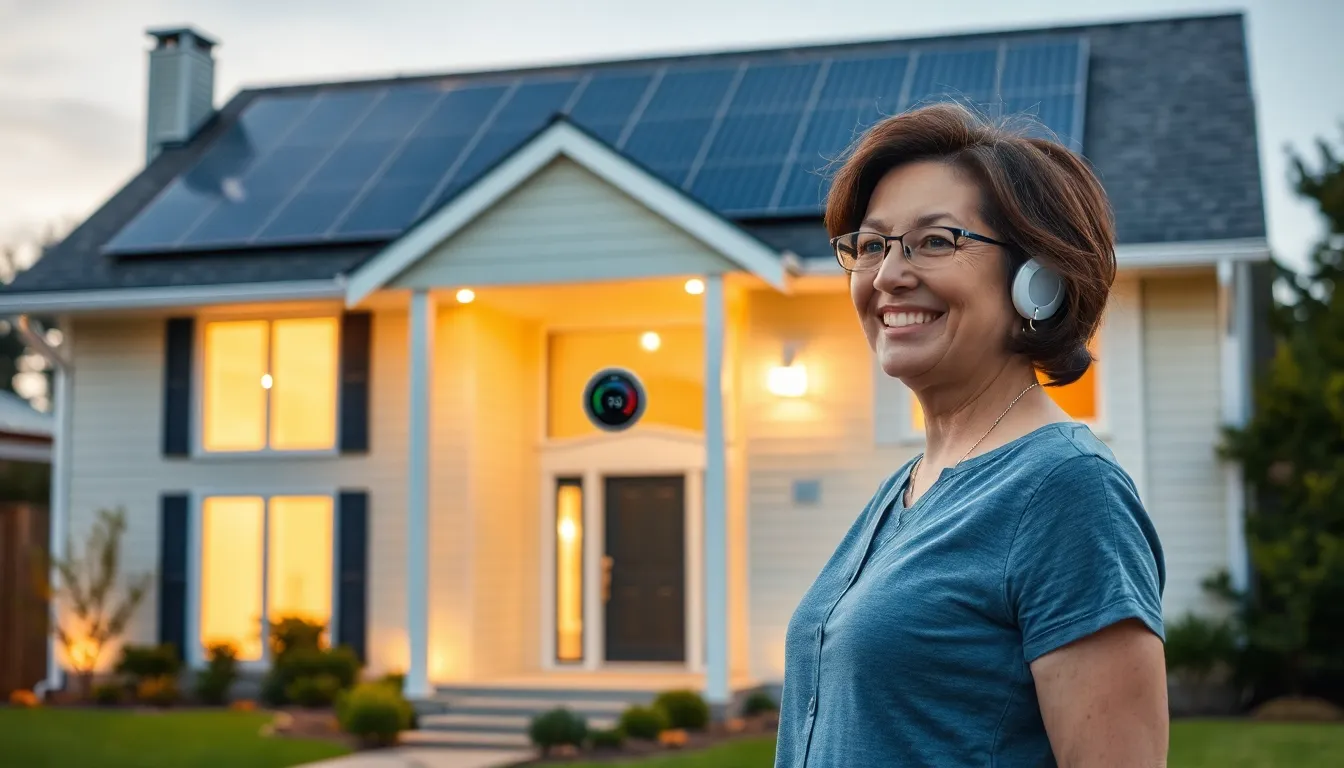Table of Contents
ToggleIn a world where energy bills can feel like a second mortgage, energy-efficient home systems are the superheroes we never knew we needed. They swoop in to save the day, cutting costs and reducing environmental impact faster than you can say “power outage.” Imagine a home that not only keeps you cozy but also gives your wallet a break—sounds like a dream, right?
These innovative systems are like a magic potion for your home, transforming it into an eco-friendly haven without sacrificing comfort. From smart thermostats that know your schedule better than your best friend to solar panels that harness the sun’s rays, energy efficiency is the name of the game. Embracing these technologies isn’t just smart; it’s downright fun! So buckle up and get ready to discover how these systems can turn your home into a lean, green, energy-saving machine.
Overview of Energy-efficient Home Systems
Energy-efficient home systems encompass various technologies designed to optimize energy usage. These systems significantly reduce energy costs while minimizing environmental impact. Smart thermostats automatically adjust heating and cooling based on occupancy, ensuring maximum comfort with minimal energy waste.
Solar panels capture sunlight to power homes, allowing homeowners to utilize renewable energy sources. Incorporating insulation materials improves a home’s thermal performance, reducing the need for heating and cooling systems. Energy-efficient appliances use less electricity or gas than standard models, contributing to substantial savings over time.
LED lighting consumes significantly less energy than traditional bulbs, delivering longer lifespans and improved efficiency. High-performance windows reduce heat transfer, keeping homes cooler in summer and warmer in winter. Homeowners often experience increased property value after implementing energy-efficient upgrades.
Smart home systems enable users to monitor and manage energy usage through connected devices, offering insights into consumption patterns. Battery storage options enhance energy independence by storing excess solar energy for later use. These innovations encourage a shift towards sustainable living.
Combined, these systems create a comprehensive approach to energy efficiency, allowing households to enjoy modern conveniences without compromising on eco-friendliness. Home improvement projects like these present opportunities for homeowners to invest in their properties while also contributing to a sustainable future. The seamless integration of energy-efficient systems simplifies daily living and fosters responsible energy consumption.
Benefits of Energy-efficient Home Systems

Energy-efficient home systems provide multiple advantages that enhance comfort and sustainability. Homeowners gain from various cost savings and reduced environmental impact.
Cost Savings
Energy-efficient home systems lower utility bills significantly. Smart thermostats optimize heating and cooling, leading to an average saving of 10 to 20 percent on energy costs. Energy-efficient appliances consume less electricity, resulting in savings over their lifespan. LED lighting uses up to 80 percent less energy compared to traditional bulbs, further reducing expenses. Additionally, higher energy efficiency may qualify homeowners for rebates and tax incentives, enhancing financial benefits. Such savings enable homeowners to invest in other areas.
Environmental Impact
Energy-efficient home systems contribute positively to the environment. They reduce greenhouse gas emissions, reflecting a commitment to sustainability. For instance, solar panels generate clean energy, minimizing reliance on fossil fuels. Efficient insulation decreases the need for heating and cooling, lowering energy consumption. Choosing energy-efficient appliances also conserves resources. By decreasing demand on power plants, these systems help preserve natural ecosystems. Overall, energy-efficient home systems promote a greener future and enhance quality of life.
Types of Energy-efficient Home Systems
Energy-efficient home systems encompass various technologies that help conserve energy and reduce costs. These systems significantly enhance a home’s sustainability and comfort.
Heating and Cooling Systems
Heating and cooling systems play a crucial role in maintaining indoor comfort. Energy-efficient models, such as heat pumps and high-efficiency furnaces, optimize energy use while providing effective temperature control. Smart thermostats, when integrated, adapt to occupant habits, further conserving energy. Regular maintenance ensures these systems operate at peak efficiency, ultimately lowering energy bills. High-performance ductwork improves airflow and minimizes energy loss. Using these advanced systems results in significant savings over time.
Renewable Energy Sources
Renewable energy sources, like solar panels and wind turbines, provide sustainable alternatives to traditional energy. Solar energy systems convert sunlight into electricity, significantly reducing utility costs. Many homeowners invest in battery storage, allowing them to store excess energy for later use. Wind turbines, although less common for residential use, can also generate clean energy on-site. Transitioning to these sources decreases reliance on fossil fuels, directly impacting environmental sustainability. In many cases, local incentives and tax credits encourage these investments, making them more accessible.
Smart Home Technologies
Smart home technologies enhance energy efficiency through automation and real-time monitoring. Devices such as energy monitors and intelligent lighting systems optimize energy usage based on need. Homeowners can track consumption patterns, allowing them to make informed decisions. Automated solutions enable systems to adjust based on occupancy and time of day, effectively managing energy resources. Integrating smart systems within a home promotes energy conservation while elevating convenience and comfort. Together, these technologies represent a forward-thinking approach to modern living.
Tips for Implementing Energy-efficient Home Systems
Implementing energy-efficient home systems involves strategic planning and careful consideration of available options. Focus on tailored solutions that meet specific needs.
Home Assessment
Conduct a thorough home assessment to identify energy inefficiencies. Inspect insulation quality, windows, and doors for air leaks. Evaluate the heating and cooling systems for their efficiency ratings. Consider using tools like energy monitors to track usage patterns. Engaging a professional energy auditor can provide valuable insights. Prioritize areas that need immediate attention for cost-effective upgrades.
Choosing the Right Products
Select energy-efficient products that align with your home’s requirements. Look for appliances with ENERGY STAR certifications, which indicate superior efficiency. Compare features among smart thermostats and choose one that meets lifestyle needs. Consider LED lighting to reduce energy consumption significantly. Investigate high-performance windows designed to minimize heat loss. Consult suppliers or online resources for reliable recommendations to ensure long-term savings.
Conclusion
Embracing energy-efficient home systems is a smart choice for homeowners looking to reduce costs and minimize their environmental footprint. By integrating advanced technologies like smart thermostats and renewable energy sources, individuals can create a comfortable living space while promoting sustainability.
These systems not only enhance energy efficiency but also increase property value and improve overall quality of life. As the demand for eco-friendly solutions grows, investing in energy-efficient upgrades becomes essential for a greener future. Homeowners are encouraged to take proactive steps in assessing their energy needs and implementing tailored solutions for lasting benefits.



